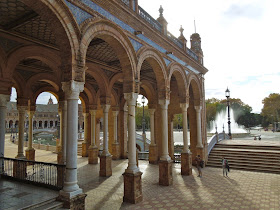Recently I was sent photographs of the Plaza de España in Seville, which was the centerpiece of the Ibero-American Exhibition of 1929, by my Australian Penpal which really took my breath away.
This enormous plaza designed by Jean-Claude Nicolas Forestier contains fountains and a Venetian-style lazy river complete with boat rides, surrounded by a semi-circular building which now houses government offices.
At the base of the building designed by architect Anibal Gonzalez which surrounds the plaza are 48 alcoves which represent the provinces of Spain, seen in the image above. These have provided great photography fodder with Spanish tourists posing in front of the alcove representing their home province.
This grand entry loggia leads one into the center of the main building and provides a shady respite from the harsh Spanish sun.
In true Spanish tradition albeit with an Art Deco twist, the ceiling of the loggia is beautifully patterned.Lets step inside the main building to the central staircase, setting of many Spanish weddings. The image below shows why!
The tilework of painted encaustic tiles is beautiful and lends human scale to the otherwise massive stair.
As if one needed another reason to visit sunny Spain, be sure to check out the Plaza de España in Seville!









Dear Stefan - I look at the layout of this grand architecture, complete with waterways, and it brings to mind a 19th century conception of Utopia. Perhaps it was.
ReplyDeleteMark, I think thats precisely what the City Beautiful movement was!! Too bad it ended....
ReplyDeleteWhat fun! I love grand, fanciful, over-sized public buildings. Like this, and like the Palace of Fine Arts in San Francisco, left over from the Panama-Pacific Exposition in 1915. (A quite remarkable survival, that.)
ReplyDeleteStefan,
ReplyDeleteYes it's unfortunate World Fairs are a thing of the past. When I was young my parents took me to the Worlds Fair in NYC.
I've never been to Spain but hope to go one day soon, especially after seeing today's post. Seville goes on my list ... The plaza's 48 alcoves is simply amazing. Thanks for the share.
Enjoy your weekend,
Vera
We do have world fairs and have done so since Crystal Palace opened up in 1851. The list of world fairs covers all those approved by the Bureau of International Expositions in Paris. I would love to say my all-time favourites were in Sydney and Melbourne in 1879 and 1880 respectively, but sadly I missed them.
ReplyDeleteTragically most structures were to be demolished as soon as a particular world fair ended. Places like the Eiffel Tower survived in Paris only through a miracle.
This is brilliant! I love all the details but the patterned tile is especially fun to see. Especially as these beautiful tiles are making a comeback. It is so true what you say about the World's Fairs. I think of that especially while visiting family in Chicago, which saw so many building come from the 1893 Columbia Exposition. Hey, btw have you read "The Devil in the White City" yet? It is a suspenseful book about the killer during that particular World Fair. It is a quick read so if not, I suggest it for the beach reading list!
ReplyDeleteI am ever fascinated by the great expositions, and their ripple effect. Even the wooden town hall in our little New England village, built in 1896, and at first glance Colonial Revival, reveals itself on closer inspection to have a definite Chicago World's Fair of 1893 vibe, not by accident. Would that the City Beautiful movement would return in this age of strip mall municipal offices.
ReplyDeleteLove this post